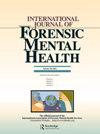How Should the Risk of Absconding Be Assessed? Existing Approaches within Forensic Mental Health Systems and Examination of a New Scale
IF 0.9
4区 医学
Q3 CRIMINOLOGY & PENOLOGY
International Journal of Forensic Mental Health
Pub Date : 2022-05-29
DOI:10.1080/14999013.2022.2078909
引用次数: 3
Abstract
Abstract At present, there are few validated tools to assist clinicians in assessing absconding risk and formulating viable risk management plans. In this article, we review existing literature on instrument validity and reliability in relation to absconding among patients in forensic care. We examine the predictive validity of a new risk assessment scale for absconding, the Waypoint Elopement Risk Scale-Historical (WERS-H), and assess its incremental utility against a general violence risk assessment instrument (HCR-20V3). Results from all active inpatients in our service (N = 139) revealed 73 individuals who were responsible for 261 absconding events from 2014 to 2020, representing a similar event frequency from a previous census conducted in 2012, but also reflecting considerable annual fluctuations in rate. Confirming results of earlier studies, the presence of substance use and lengthy durations of forensic supervision emerged as key variables associated with absconding. The WERS-H was found to be a significant predictor of future absconding events (incident rate ratio = 1.21, 95% CI [1.07, 1.38], p = .002) and contributed incrementally over the HCR-20V3 Historical scale, suggesting that the use of an absconding-specific risk tool may yield better predictive accuracy compared to assessment instruments in the domain of general violence or offending.如何评估潜逃风险?法医心理健康系统的现有方法与新尺度的检验
目前,很少有有效的工具来帮助临床医生评估潜逃风险并制定可行的风险管理计划。在这篇文章中,我们回顾了现有的文献关于仪器效度和信度在法医护理患者中潜逃。我们检验了一种新的潜逃风险评估量表,即路径点私奔风险量表-历史(WERS-H)的预测有效性,并评估了其相对于一般暴力风险评估工具(HCR-20V3)的增量效用。我们服务的所有活跃住院患者(N = 139)的结果显示,从2014年到2020年,73人对261起潜逃事件负责,这与2012年进行的前一次人口普查的事件频率相似,但也反映了相当大的年度波动。证实早期研究的结果,药物使用的存在和长时间的法医监督成为与潜逃相关的关键变量。研究发现,WERS-H是未来潜逃事件的重要预测因子(发生率比= 1.21,95% CI [1.07, 1.38], p = .002),并且在HCR-20V3历史量表上的贡献逐渐增加,这表明与一般暴力或犯罪领域的评估工具相比,使用潜逃特定风险工具可能产生更好的预测准确性。
本文章由计算机程序翻译,如有差异,请以英文原文为准。
求助全文
约1分钟内获得全文
求助全文

 求助内容:
求助内容: 应助结果提醒方式:
应助结果提醒方式:


